Click on images to enlarge

infestation (Photo: Sheldon Navie)
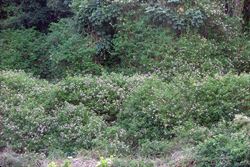
infestation (Photo: Sheldon Navie)
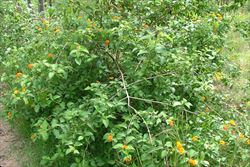
shrubby habit (Photo: Sheldon Navie)

climbing habit (Photo: Sheldon Navie)

thick woody stems of old plant (Photo: Sheldon Navie)

close-up of older stem with prickles (Photo: Sheldon Navie)
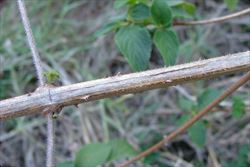
younger four-angled stem (Photo: Sheldon Navie)
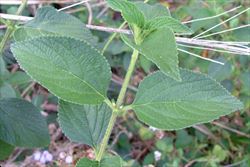
paired leaves and young stem (Photo: Sheldon Navie)
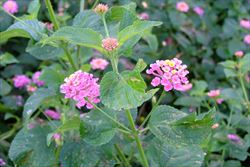
flower clusters in the leaf forks (Photo: Sheldon Navie)
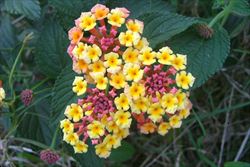
flower clusters (Photo: Sheldon Navie)
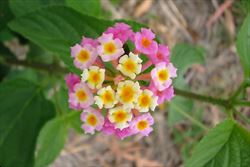
pink flowered form (Photo: Sheldon Navie)
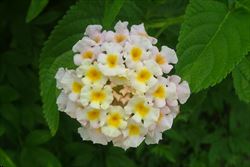
white flowered form (Photo: Sheldon Navie)

orange flowered form (Photo: Sheldon Navie)
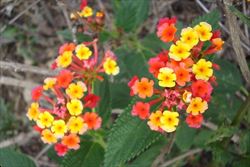
pink-edged red flowered form (Photo: Sheldon Navie)

red flowered form (Photo: Sheldon Navie)
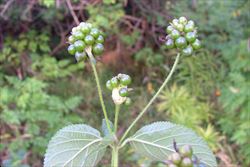
immature fruit and leaf undersides (Photo: Sheldon Navie)
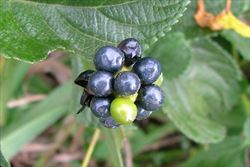
close-up of mature fruit (Photo: Sheldon Navie)
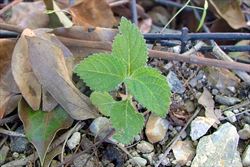
seedling (Photo: Sheldon Navie)
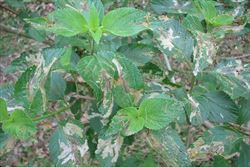
leaf damage caused by biocontrol agents (Photo: Sheldon Navie)
Scientific Name
Lantana camara L.
Note: Lantana strigocamara R.W. Sanders - may soon become accepted as the name for the "species" that is widely naturalised in Australia.
Synonyms
Camara vulgaris Benth.Lantana aculeata L.Lantana armata SchauerLantana scabrida Sol.Lantana tiliifolia Cham.
Family
Verbenaceae
Common Names
arch man, common lantana, curse of India, kamara lantana, lantana, large-leaf lantana, largeleaf lantana, pink flowered lantana, pink-flowered lantana, prickly lantana, red flowered lantana, red flowered sage, red sage, red-flowered lantana, red-flowered sage, shrub verbena, tick berry, white sage, wild sage, yellow sage
Origin
Native to Mexico, Central America, the Caribbean (i.e. the Bahamas, Cuba, Hispaniola, Jamaica and Puerto Rico) and tropical South America (i.e. Venezuela and Colombia).
Note: The lantana populations that have become naturalised in Australia and other parts of the world are thought to have originated from various cultivated hybrids and are not the same as the natural populations of Lantana camara from tropical America. Therefore, it has been suggested that the weedy populations derived from cultivated material be called Lantana strigocamara, to differentiate them from true Lantana camara.
Cultivation
Many weedy and non-weedy cultivars of this species have been grown as garden ornamentals in Australia.
Naturalised Distribution
This species is widely distributed and very common in the coastal and sub-coastal areas of eastern Australia from Cairns south to the central coast of New South Wales. It is also present in Western Australia, in the northern parts of the Northern Territory, in Victoria, in south-eastern South Australia, on Lord Howe Island and on Norfolk Island.
Also widely naturalised in other parts of the world, including on many Pacific Islands (e.g. in American Samoa, Western Samoa, the Cook Islands, the Galapagos Islands, the Federated States of Micronesia, Fiji, French Polynesia, Guam, Hawaii, Nauru, New Caledonia, Niue, Palau, and the Solomon Islands), in Africa (e.g. Kenya, Uganda, Tanzania and South Africa), in India and in south-eastern Asia (i.e. Papua New Guinea, the Philippines, Cambodia, China, Indonesia, Malaysia, Singapore, Thailand and Vietnam).
Habitat
A wide-ranging species found predominantly in tropical and sub-tropical environments, but also capable of growing in warmer temperate and semi-arid regions. It is a weed of roadsides, waterways, coastal environs, railways, fence-lines, waste areas, disturbed sites, closed forests, forest margins, grasslands, plantation crops, pastures and parklands. However, it is most commonly found growing in the understorey of open woodlands.
Habit
A much-branched, upright (i.e. erect), arching or scrambling shrub that usually grows 2-4 m tall and forms dense thickets. It can occasionally grow like a vine (i.e. as a scandent shrub) if given support by other vegetation, in which case it can reach up to 15 m in height.
Distinguishing Features
- a rough-textured and usually prickly shrub with oppositely arranged leaves.
- its dense flower clusters consist of numerous small tubular flowers (9-14 mm long and 4-10 mm across).
- these flower clusters are borne on stalks originating in the leaf forks.
- the flowers can be a wide variety of colours (i.e. white, yellow, orange, red, pink or multi-coloured).
- its mature fruit (5-8 mm across) are glossy in appearance and black, purplish-black or bluish-black in colour.
Stems and Leaves
The young stems are usually green and square in cross-section (i.e. quadrangular). They are rough to the touch, often armed with short backwards-curved (i.e. recurved) prickles, and can sometimes be slightly hairy (i.e. puberulent). As they mature the stems become rounded and turn grey or brown in colour (growing up to 15 cm thick).
The simple leaves are oppositely arranged along the stems and borne on stalks (i.e. petioles) 5-20 mm long. They have toothed (i.e. crenated or serrated) margins and a somewhat wrinkled (i.e. rugose) appearance. The leaf blades (2-13 cm long and 1.5-7 cm wide) are mostly egg-shaped in outline (i.e. ovate) with pointed tips (i.e. acuminate apices). The texture of the leaves is usually quite rough (i.e. scabrous), however the undersides are usually softly hairy (i.e. pubescent).
Flowers and Fruit
The small flowers are borne in dense clusters (2-4 cm across), with each cluster containing about 20-40 flowers. These flower clusters are borne on stalks (i.e. peduncles) 2-10 cm long that originate in the leaf forks (i.e. axils). Individual flowers are tubular (9-14 mm long and 4-10 mm across) and may be a great variety of colours (i.e. white, cream, yellow, orange, red, pink or multi-coloured). They consist of four (rarely five) petals that are fused for most of their length into a tube (i.e. corolla tube) and split into small lobes at their tips. Flowering occurs throughout most of the year, but is most apparent during the spring and summer months.
The slightly fleshy (i.e. succulent) fruit resemble 'berries' (they are actually drupes). These small fruit (5-8 mm across) are initially glossy green in colour but turn black, purplish-black or bluish-black as they mature mature. Each fruit contains a single hard and stony seed (2-4 mm long) at its centre. These seeds are light brown in colour and egg-shaped (i.e. ovoid).
Reproduction and Dispersal
This plant commonly reproduces by seeds, which are readily dispersed by birds and other animals (e.g. rodents) that eat the fruit. Existing colonies may also spread laterally via the production of suckers or when branches take root after coming into contact with the soil (i.e. by layering). Stem fragments or pieces of the rootstock (i.e. crown) can also give rise to new plants after being moved by machinery or dumped in garden waste.
Environmental Impact
Lantana (Lantana camara) is one of the 20 Weeds of National Significance (WoNS) in Australia. It is regarded as a significant environmental weed in Queensland, New South Wales, and on Norfolk Island, and as a potentially significant environmental weed in Western Australia and the Northern Territory. This species is actively managed by community groups in Queensland and New South Wales, and was recently ranked as the most serious enviromental weed in south-eastern Queensland.
It is also listed in the Global Invasive Species Database (GISD) and is regarded to be in the top 100 of the world’s worst invasive alien species.
Other Impacts
Legislation
This species is declared under legislation in the following states and territories:
- ACT: C4 - prohibited pest plant (a pest plant whose propagation and supply is prohibited).
- New South Wales: Class 3 - a regionally controlled weed. The relevant local control authority must be promptly notified of the presence of this weed and it must be fully and continuously suppressed and destroyed (in the Bega Valley, Eurobodalla and Lord Howe Island local authority areas). Class 4 - a locally controlled weed. The growth and spread of this species must be controlled according to the measures specified in a management plan published by the local control authority and the plant may not be sold, propagated or knowingly distributed (in a large number of local authority areas). Class 5 - a restricted weed which must not be sold, bought or knowingly distributed (throughout the entire state). See the New South Wales Department of Primary Industries Noxious Weeds List at http://www.dpi.nsw.gov.au for more detailed information on which local areas are covered in these declarations. This declaration applies to all lantana species (Lantana spp.).
- Northern Territory: B - growth and spread of this species to be controlled (in areas outside of towns), and C - not to be introduced into the Territory.
- Queensland: Class 3 - this species is primarily an environmental weed and a pest control notice may be issued for land that is, or is adjacent to, an environmentally significant area (throughout the entire state). It is also illegal to sell a declared plant or its seed in this state. This declaration applies to all lantana species (Lantana spp.).
- South Australia: 11+ - Class 11 is a category for those species that are 'Weeds of National Significance' but not otherwise declared in South Australia. Control of this species is not currently required in this state.
- Tasmania: D - the importation or sale of this species is prohibited and measures to reduce its population in an area, eradicate it from an area, or restrict it to a particular area may be required.
- Victoria: R - a restricted weed that cannot be sold or traded in this state.
- Western Australia: P1 - trade, sale or movement into the state prevented.
Management
For information on the management of this species see the following resources:
- the Lantana Control Manual, which is available online at http://www.weeds.org.au/docs/Lantana_Management.pdf.
- the National Weeds Strategy Strategic Plan for this species, which is available online at http://www.weeds.org.au/docs/lanstrat.pdf.
- the Biosecurity Queensland Fact Sheet on this species, which is available online at http://www.dpi.qld.gov.au.
- the Northern Territory Department of Natural Resources, Environment and The Arts Agnote on this species, which is available online at http://www.nt.gov.au/weeds.
Similar Species
Lantana (Lantana camara) is relatively similar to creeping lantana (Lantana montevidensis). However, creeping lantana (Lantana montevidensis) has a creeping (i.e. prostrate) growth habit and does not have prickles or thorns on its stems.

